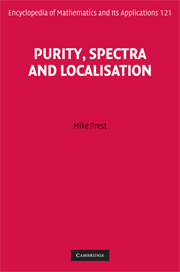18 - Definable categories and interpretation functors
from Part III - Definable categories
Published online by Cambridge University Press: 05 March 2013
Summary
Definable subcategories and categories of exact functors on small abelian categories are shown to be equivalent. It turns out that the functor category of a definable category has an intrinsic definition. Functors which preserve products and direct limits are introduced as the “appropriate” functors between definable categories and these are mirrored by exact functors between the associated functor categories/categories of imaginaries. Those functors between definable categories which preserve direct limits and products are shown to be exactly the modeltheoretic interpretation functors. A variety of examples is presented.
Definable categories
Definable subcategories are represented as categories of exact functors in Section 18.1.1 and the converse is shown in Section 18.1.2. The dual of a definable category is defined in Section 18.1.1.
One way of obtaining the functor category of a definable category intrinsically is given in Section 18.1.3; a simpler description is in Section 18.1.4.
Definable subcategories
The elementary dual of a definable subcategory is defined: the respective functor categories are dual (18.1.3). Every definable category is the category of exact functors on its functor category (18.1.4).
Let C be a finitely accessible additive category with products (Section 16.1.1, esp. 16.1.12) and let D be a full subcategory of C.
- Type
- Chapter
- Information
- Purity, Spectra and Localisation , pp. 667 - 695Publisher: Cambridge University PressPrint publication year: 2009



